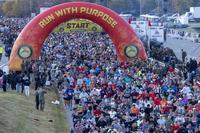Starting a running plan is often a risky journey as many will start out doing too much, too soon. Depending on your running goals, the endurance and speed increases required to pass military fitness tests vary from branch to branch and from events like shuttle runs, 1.5- to three-mile timed runs and sprints.
With running, it is much easier to injure yourself than to get into healthy running shape. This is a great question from a young man preparing for the longer timed run events who is curious what to look out for when starting a running plan:
Hello, Sir. What symptoms are you looking for to determine when to sub in low impact for running? I know you usually say week three to lower the impact. I started a running plan and think I need to reduce some of the miles, as I am not ready to do 15-20 miles a week yet. Any advice is appreciated. Thanks, Alex
Alex: Great question. My first piece of advice for you is to personalize any workout or running program to fit your abilities. In this case, reducing the total miles per week is logical.
You should also read the Rules to Avoid Shin Splints and More. This article breaks down the four main injuries people create by doing too much, too soon on a program that is not personally developed for them. They are Runner's Knee (Patellofemoral Pain Syndrome, or PFPS), Iliotibial (IT) Band Syndrome, Plantar Fasciitis and Shin Splints,
If you look into each of the above ailments, you will see a long list of symptoms, but the most common symptoms are the following:
Pain in Feet
A proper fitting shoe will help tremendously with typical pains in the feet, whether soft tissue or bone. Wearing old shoes, running on hard ground all of the time and improper running strides can quickly lead to pain in your feet, such as plantar fasciitis listed above.
Massaging and rolling the feet daily before and after will help, but a good pair of running shoes is essential to helping with nearly all running pain (as much as limited total volume when starting). Learn how to buy shoes from a shoe or running professional. If it hurts to walk, don't run and resort to non-impact cardio options.
Pain in Ankles or Shins
Ankle mobility is going to help you with the typical pains of running. If running on uneven terrain, consider high-top boots or ankle braces to avoid traumatic-type injuries caused by sprains and twists.
By stretching the shins and calves before and after running, you will help to improve your ankle mobility. Avoid sprinting, jumping or hill running without a proper warmup. Being warmed up will also help you reduce the risk of injury to the Achilles tendon. Resort to non-impact cardio if stretching the shins and ankles is not helping with relieving any pain.
Pain in Knees
Knee pain tends to be the most common of all running pains. If you feel it walking down steps, you could be starting some IT band flareup. If you feel it walking up steps, it could be runner's knee, patellar tendinitis or general wear and tear with bone and cartilage. If you find the pain goes away after warming up, it is likely tendinitis (in any joint).
If it comes back while sitting for a while after running, it is more likely to be tendinitis. Massaging, stretching and foam rolling of the muscles above and below the knee will help. Wearing a compression sleeve may also help relieve pain. If it does not, then reduce running and resort to non-impact cardio.
Pain in Hips
Hips tend to be more resilient than the above areas of the body, but when they hurt, you know it when you run. Simply having tight hips can shorten your stride, slow your running and cause pain when making an impact with the ground.
Consider a mobility day and get in the water to tread and do dynamic stretches in chest-deep water. I have found that to be life-changing in my ability to continue running without hip pain.
Muscle Soreness
Any new activity will cause some sort of muscle soreness, whether it is running more than normal, sprinting for the first time or running hills. Once again, a warmup and cooldown are essential to reducing running pains typical with new running plans.
Just how important are cooldowns? See this article on the topic. They're just as important as warmups.
Proper Warmup = Key to Avoiding Pain
Prior to running, my first mile of any run is the warmup. During this mile (or 10-minute bike), it is slow, focusing on rhythm and stride length as I slowly begin to open to more of a running or jogging pace and stride. Also consider stretching the muscles needed in this run from your heels to your hips after this mile warmup.
With pain and running, I have three rules:
- If it hurts to run, stop running.
- If it hurts to walk, don't run.
- If it hurts doing nothing, go to a doctor. Regardless of the test you are training for, you could cross the line and injure yourself if you are not preparing smartly.
Stew Smith is a former Navy SEAL and fitness author certified as a Strength and Conditioning Specialist (CSCS) with the National Strength and Conditioning Association. Visit his Fitness eBook store if you're looking to start a workout program to create a healthy lifestyle. Send your fitness questions to stew@stewsmith.com.
Want to Learn More About Military Life?
Whether you're thinking of joining the military, looking for fitness and basic training tips, or keeping up with military life and benefits, Military.com has you covered. Subscribe to Military.com to have military news, updates and resources delivered directly to your inbox.



















